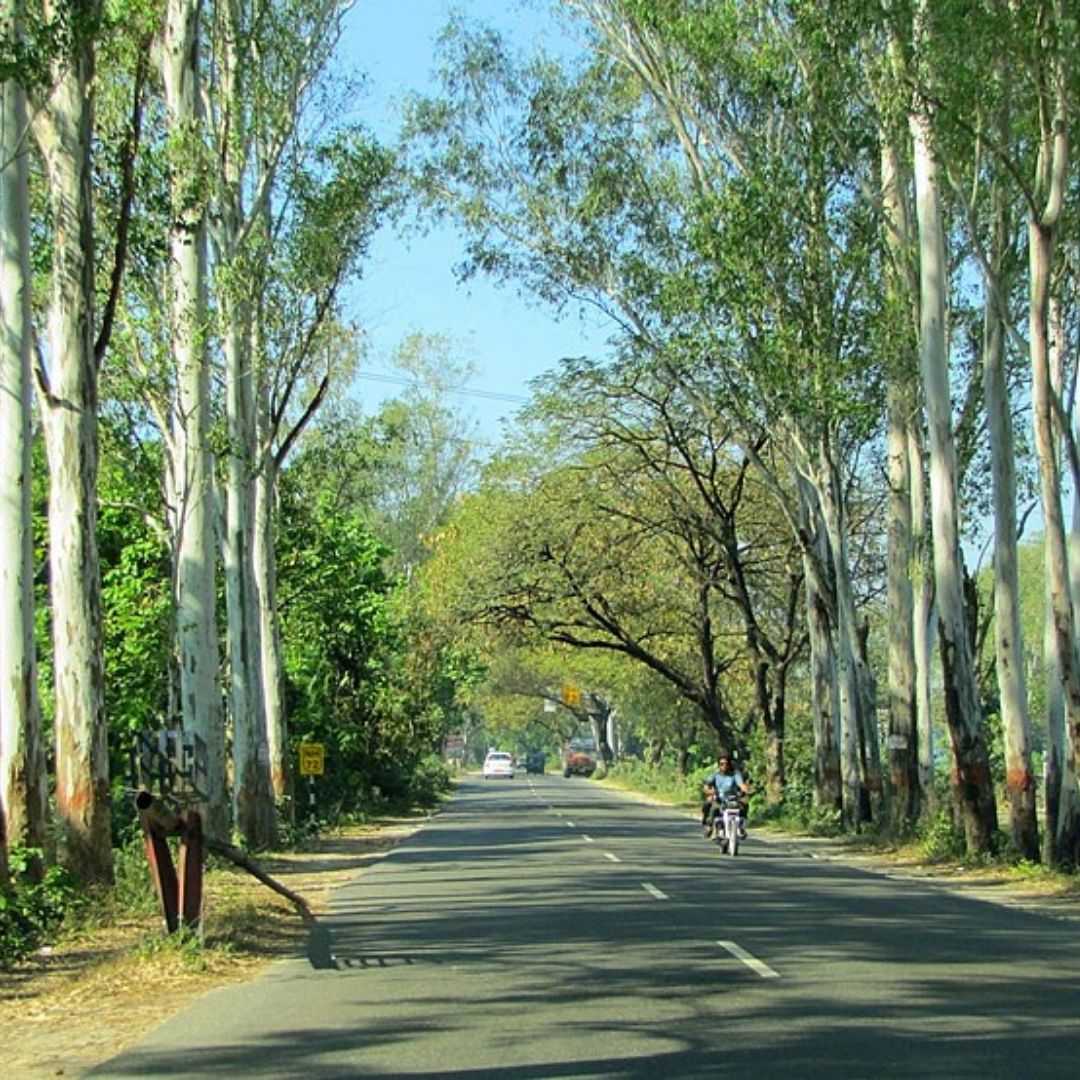
Image Credits: Wikipedia
International Day Of Forests: Eucalyptus Cultivation In India, A Boon Or A Curse?
India, 21 March 2022 11:46 AM GMT
Editor : Snehadri Sarkar |
While he is a massive sports fanatic, his interest also lies in mainstream news and nitpicking trending and less talked about everyday issues.
Creatives : Tashafi Nazir
For most people, journalism sounds hectic and chaotic. For her, it's a passion she has been chasing for years. With an extensive media background, Tashafi believes in putting efforts on presenting a simple incident in the most interesting way.
Foresters maintain that Eucalyptus can help meet rising wood demands from dwindling natural forests, supplying local communities and industry. However, environmentalists are opposed to Eucalyptus due to perceived ecological hazards and the charge that the choice of species is fundamentally flawed.
Over the last two decades, large-scale planting of Eucalyptus, as a fast-growing exotic, has occurred in India as part of a drive to reforest the subcontinent and create an adequate supply of fuel and timber for rural communities.
Foresters maintain that Eucalyptus can help meet rising wood demands from dwindling natural forests, supplying local communities and industry. However, environmentalists are opposed to Eucalyptus due to perceived ecological hazards and the charge that the choice of species is fundamentally flawed. Eucalyptus is ill-equipped to serve the variety of diverse end uses demanded of tree species in India for community use.
Eucalyptus is cultivated in almost all parts of the country, and the most suited variety from the 700 available species are picked as per the region of cultivation.
Andhra Pradesh, Telangana, Tamil Nadu, Punjab, Haryana and Karnataka are a few states that produce the bulk of eucalyptus in India, which suffices the demands of the timber, pulp and paper industries. However, in 2017, Karnataka banned eucalyptus, citing four academic papers.
History
Eucalyptus has a long history in India. It was first planted around 1790 by the ruler of Mysore Tippu Sultan in his palace garden on Nandi hills near Bangalore. History says that he received seed from Australia and introduced about 16 species.
After the planting at Nandi Hills, the following significant introduction of Eucalyptus was in Tamil Nadu's Nilgiri hills in 1843, and later (1856) where regular plantations were raised to meet the demands for firewood. There were many other attempts to introduce eucalypts in various parts of India.
Criticisms of Eucalyptus
Despite the enthusiasm with which eucalyptus has been promoted and received by policymakers and forest department officials, its large-scale establishment in India since the early 1980s has invoked passioned criticism from environmentalists, social activists and some NGO's. The most vocal in the condemnation of eucalyptus is the writer and environmentalist, Vandana Shiva. She charges the plant with nothing less than ecological fascism. Although criticised political and socio-economic grounds, the environmentalist roundly destroys the case for Eucalyptus in India on scientific and environmental grounds.
Eucalyptus is water-intensive and reduces available water for other species by effectively out-competing them. In arid areas, it consequently suppresses different plant life, coupled with high water demand, reduces soil moisture, prevents groundwater recharge, and can reduce local water tables. This is worsened by a high transpiration rate indicative of the inefficient use of water.
Shiva maintains that in 'vulnerable ecozones', like the Deccan Plateau in the rain shadow of the Western Ghats, introducing species with high water demand will 'destroy the hydrological balance' of these areas contribute to rising acidity, soil erosion and eventual desertification. Particularly vulnerable are arid areas with yearly rates of precipitation that correspond to the lower range of Eucalyptus demand, about 700mm, according to a study.
Eucalyptus does not promote the building of humus. It does not contribute to the soil's long-term fertility, as other species might, resulting in an overall nutrient impoverishment of the soil.
Eucalyptus is toxic due to its allelopathic properties, which reduce other plant life by restricting germination of other species and is also detrimental to soil micro and macrofauna.
Eucalyptus and nutrient budgets
Shiva claims Eucalyptus can undermine arid regions' biological productivity by its excessive nutrient demand, creating deficits for other plant life. A slight return of litter to the forest floor and poor humus building consequently reduces fertility, resulting in the soil's overall impoverishment. Shiva cites a study of Singh, (1984), where the nutrient demand by Eucalyptus was found to be 100 kg of phosphorous, 217 kilograms of nitrogen and 1594 kg of calcium per hectare per year.
Even in the nutrient-poor soils of Australia, Attwell, followed the distribution and movement of nutrients within a forest of E. Obliqua, and found demand for phosphorous, potassium and calcium per hectare, per year, to be 36 kg, 272 kg and 400 kg respectively.
Although Eucalyptus can complete their life cycle on sites of low nutrient status, the genus retains the ability to respond favourably to improved nutritional quality. When introduced to an environment with higher nutrient levels, particularly phosphorous and nitrogen, increased productivity and vigour is markedly responded. Therefore, productivity is largely dependent on its access to nutrients.
Toxic Eucalyptus?
Allelopathic species suppress their progeny and other plant life by leaching chemical inhibitors from the trees' roots or litter. Several studies describe the poor effects of Eucalyptus on crops in India. Basu et al, 1987, Narwal, 1990, and Suresh and Vinai Rai, 1987, Saxena, 1994, all found Eucalyptus to reduce the yield of rabi, when planted between fields. The plant was found to have the highest allelopathic effect.
Present Condition
Before the Karnataka High Court banned eucalyptus for being a water guzzler, it bore the brunt of something similar at the National Green Tribunal in 2015. Safal Bharat Guru Parampara Punjab filed a case, stating extreme overutilization of groundwater in Punjab and citing commercial eucalyptus cultivation as one of its reasons.
Punjab and Haryana High Court gave the landmark judgement and stated that if the proper management of eucalyptus cultivation is undertaken, its growth is neither anti-environment nor disastrous for the water table. The bench of April 16, 2015, further reiterated that there could not be a complete ban on eucalyptus plantation in Punjab. However, the forest department was held responsible for evolving appropriate policy by regulating and restricting the growth of the said plantation in the waterlogged and safe areas through proper regulations and continuous monitoring.
According to a Centre for Science and Environment (CSE) report, eucalyptus plantations yield more net income to farmers than nearly 60-70 per cent of agriculture crops. It can play a significant role in increasing future farm-level income, on the back of new productive clones currently under development.
A Food and Agriculture Organisation (FAO) report 2014, said nearly 93 per cent of the industrial wood requirement of India is met out of farm/agroforestry plantations (about 70% of which is eucalyptus). It has benefitted the farmers and the industry and has reduced pressure on forests.
Out of the country's total 328.73 million ha of geographical land, 25.98 million ha comprises farmer-owned uncultivated wasteland. Trees like eucalyptus help increase farmers' income and fulfil the government's target of covering the geography with 33 per cent of forests, which currently pegs at only 22 per cent.
Also Read: This US-Based Sikh Organisation Plants 400 Forests, Fights To Save Trees Worldwide
 All section
All section














